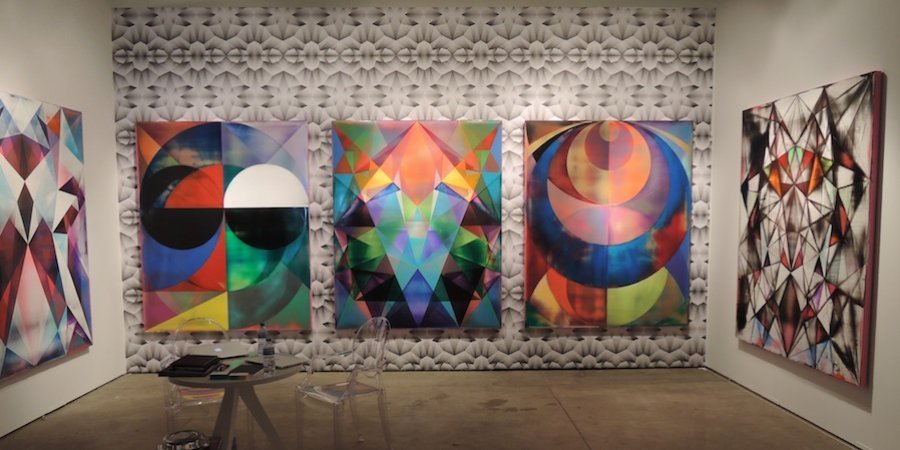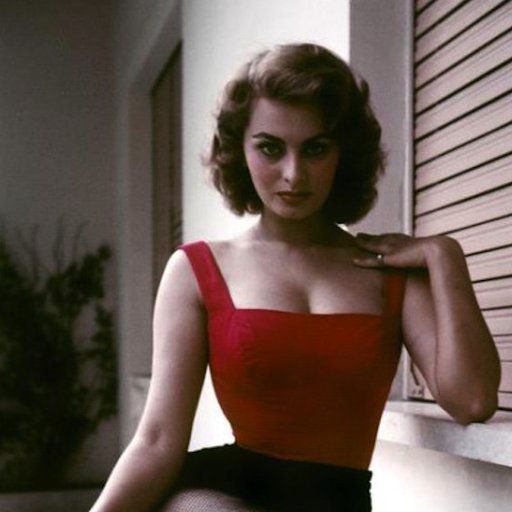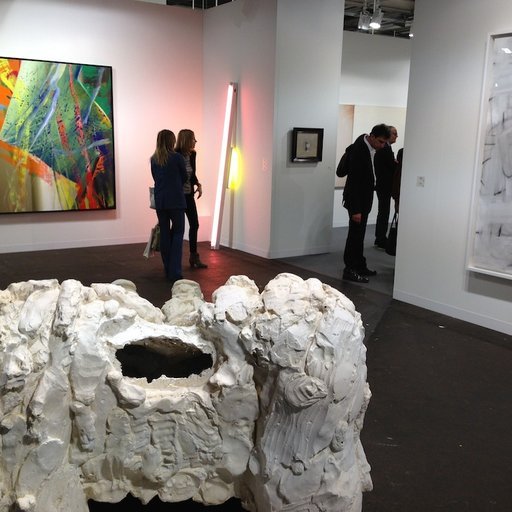SHANNON FINLEY AT JESSICA SILVERMAN GALLERY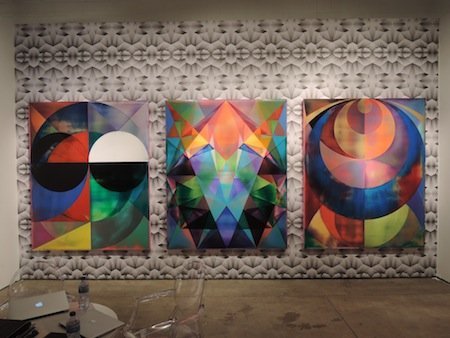
The San Francisco dealer Jessica Silverman has a knack for putting together memorable booths at art fairs, and her selection of paintings by the Canadian-born, Berlin-based artist Shannon Finley was a knockout, presenting a suite of abstractions that the artist created by using a palette knife to apply acrylic that he mixed with gels for a satiny, opalescent effect. Referencing a wide swath of visual culture, from Futurism and the work of artists like Gerhard Richter to early video game design, the work is only the gallery's second presentation of the 30-something artist, who was recently featured in a rare paintings show at Berlin's KW Institute for Contemporary Art and is getting a tremendous amount of interest from curators and collectors.
OSCAR MURILLO'S FOUR (2013) AT DAVID ZWIRNER GALLERY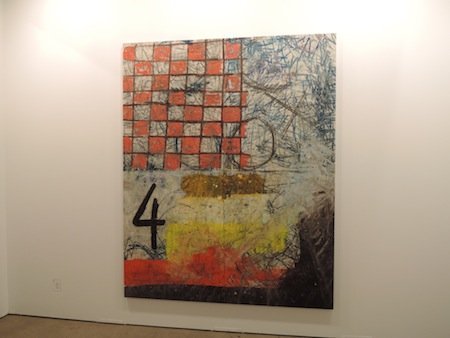
Only 27 years old, the Colombian-born, London-based artist Oscar Murillo may be biggest breakout sensation of the year, gaining a hot-in-the-collar collector base for the paintings that he creates during festive performances he holds at his home studio, often incorporating members of his family who help him stitch together the messy pieces he creates—he walks all over his canvases, celebrating what he calls "the pollution of the studio"—into large compositions. A sensation since the Rubell Collection presented a series of giant commissioned paintings in Miami last December (he now has a solo show at the Studio Museum in Harlem coming up), Murillo was recently snatched up by David Zwirner, who presented this painting (in the $120,000 range) at the fair that was swiftly acquired by Larry and Marilyn Fields—just minutes before a 2011 painting by the artist, estimated at $30,000 to $40,000, sold for $401,000 at the Phillips "Under the Influence" auction in New York.
ALEXANDRE DA CUNHA'S TERRACOTTA EBONY IX (2013) AT CRG GALLERY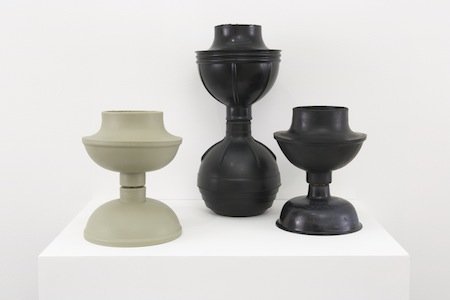
Gallery-goers in New York may remember Alexandre da Cunha from his attention-grabbing show at CRG Gallery last year, which presented the Brazilian-born, London-based artist's sly configurations of found objects, from woven hats protruding from canvasses to woven tapestries made from mops. This modest sculptural group here, made from toilet plungers attached at their ends with invisible corks to echo traditional still lifes (particularly Morandi's), is emblematic of da Cunha's charming style, which has captivated Brazilian collectors including Bernardo Paz, who is installing a giant cement-mixer sculpture by the artist at his renowned Inhotim sculpture park (another version will be on view at Frieze next month).
GLENN KAINO AT HONOR FRASER GALLERY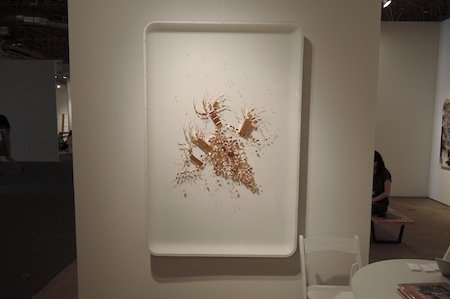
Currently showing in the Lyon Biennial, the Los Angeles artist Glenn Kaino has in recent years been working on an absorbing series of wall pieces that employ what model-makers call "kit bashing," the rejection of the instructions that come with a model kit in favor of using the parts to make abstract new compositions. At Honor Fraser's booth, this piece, in which pieces from various different toys (tanks, cars, etc.) are dipped in gold and then isolated on pins in a plastic tub covered in Plexi, is the first to make reference to an ambitious installation that he has planned for Franklin Sirmans's much-anticipated Prospect New Orleans exhibition next year, which will involve creating entire ecosystems of parts within fish tanks.
MARCELO GROSMAN's MASCULINO 26-30, #4 (2012) AT THE MISSION GALLERY
To create this body of work at Chicago's MISSION gallery, the Argentine-born artist Marcelo Grosman accessed the Cook County prison database to search for certain categories—say, males between 26 and 34 who had been arrested for domestic violence—and then compiled the photographs of between 50 and 200 inmates who met the criteria into composite portraits. The ghostly resulting pieces, which recall both police sketches and the typological investigations of photographers like August Sander, are also intended by the artist to be critiques of systems of institutional oppression, in which the individuality of these offenders is blurred away as they are reduced to a generic data point.
MARTÍN RAMÍREZ'S UNTITLED (CABALLERO IN RED SHIRT NO. 2) (1950-55) AT RICCO/MARESCA GALLERY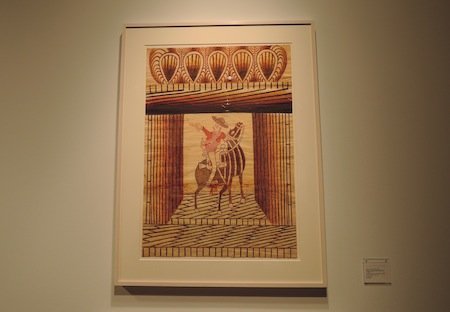
Born in Mexico in 1895, Martín Ramírez left behind his wife and children to find work in California, where he lived on the streets, illiterate and unable to speak English, until he was picked up by the police and consigned into a lifetime of institutionalization in mental hospitals. Believed to be mute for many years and labeled as schizophrenic (though today that diagnosis is questionable), he began creating drawings on scraps of paper that he found around the hospital and stitched into larger sheets, building a voluminous body of astonishing work notable for its haunting graphic sensibility and tendency to evoke Ramírez's memories of Mexico. His drawings garnered the attention of hospital staff, and was purchased from him by his doctors, as well as by the artist Jim Nutt and his wife, who acquired a large collection of his work (including this striking piece, now priced at $130,000). In recent years, since Ramírez passed away, his family in Mexico learned about the prices being fetched by his work and sued his collectors, successfully contending that the artist was incapable of negotiating fair prices for his work and winning large settlements. Ricco/Maresca Gallery now works with the Ramírez's estate, and recently made headlines when a trove of 140 new drawings were discovered in the garage of one of the artist's doctors.
TODD CHILTON'S WHITE RAMPS (2013) AT RHONA HOFFMAN GALLERY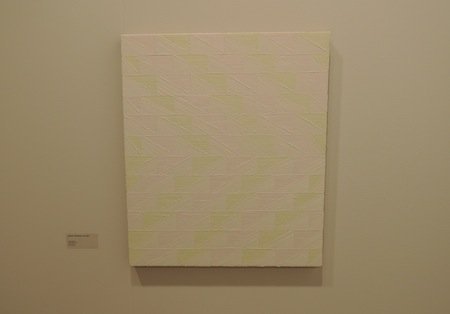
A graduate of the Art Institute of Chicago, the young local artist Todd Chilton creates richly painted abstractions that are paired with descriptive titles that guide the viewer to look at the work from a certain perspective. At Rhona Hoffman, this painting, consisting of rows of white triangles paired with yellow or pink triangles, is transformed by the title into a series of miniature landscapes, with white ramps rising under delicately colored skies—all of it rendered by hand, without any formal measurements, to for a subtly lively pictorial effect.
TOM FRIEDMAN'S UNTITLED (WHITESCAPE WITH BLUE), 2013 AT LUHRING AUGUSTINE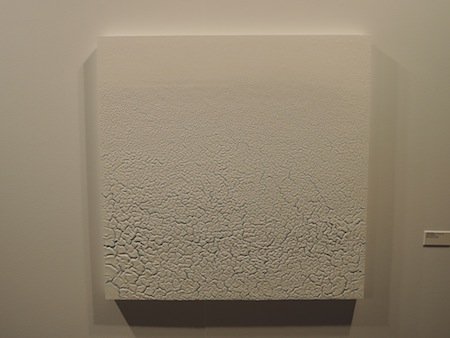
The artist Tom Friedman concocted a novel process to make this piece: taking a sheet of plastic, he covered it with Pam cooking spray—with more at the top than the bottom—and then painted it white, waited for the paint to dry, and then peeled it off and applied it to a blue styrofoam panel. Following up on a series of "seascapes" that the artist made by folding a piece of paper in half and crinkling the bottom, sending collectors into a frenzy, the resulting piece evokes a view of arctic waters seen from the prow of a ship as it breaks through an expanse of ice floes
CAROLEE SCHNEEMANN'S DARK POND (2001-2005) AT P.P.O.W. GALLERY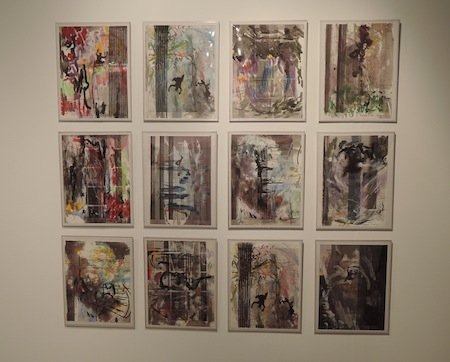
Famous for her seminal body-oriented performance pieces—like the orgiastic 1964 Meat Joy, in which she and a group of other bathing-suit-clad performers wriggled around on the floor in a mixture of raw fish, chicken, and sausage and paint—Carolee Schneemann has always viewed herself as a painter first and foremost, whether she uses her body or a brush to make her compositions. She has also never shied away from engaging head-on with the most controversial political issues of the day at times when other artists might view them as off-limits, from her outraged pieces during the early days of the Vietnam War to this series of works, for which she rephotographed newspaper images of people falling from the World Trade Center during the 9/11 attacks and then hand-colored them with expressionistic marks. Now 73, Schneemann lives on a farm in upstate New York, and is the subject of a new documentary called Breaking the Frame—debuting at Lincoln Center in October—that explores how her rustic surroundings have informed her work.











